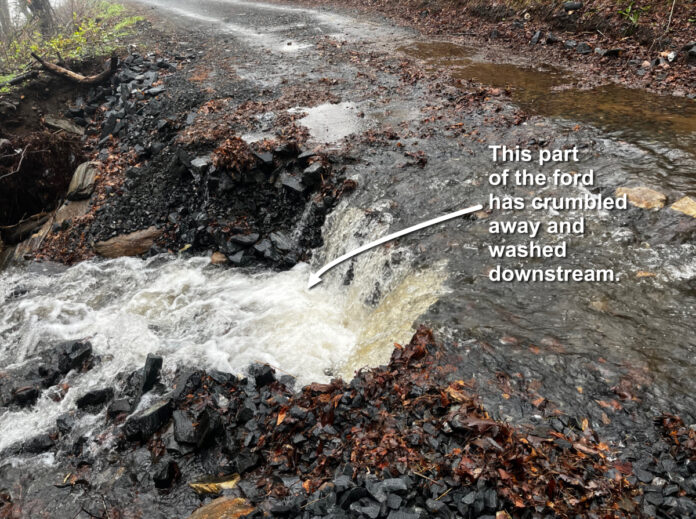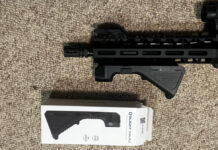
We escaped the flooding that hit much of the middle part of the country this past week, but we still had three inches of rain in one night. That caused some erosion on the scar left behind by the landslide, no doubt washing away many of the seeds we had planted. it also generated enough new mud to cover up much of the grass we planted.
Worse yet was the damage the torrential rain it did to the ford, which is where the road crosses the creek. The ford had been there for more than 25 years when Helene washed it out, and it took five weeks for the department of transportation to do a “temporary repair.” After the rains, we now need a repair to the repair because a good deal of the rip-rap and other rock and gravel they put down to build up the creek bed was carried away by the rush of water.
DOT was responsive in that they sent someone out to inspect the damage within hours after we called, but it has not yet been repaired. My guess is they are waiting for the water level to drop back down to something closer to normal. With any luck, they will bring boulders this time and rebuild it with larger rocks the water is less likely to wash away.
In the meantime, we are back to parking down the mountain and walking up and down. If we have a load of stuff to carry, we can borrow the neighbor’s side-by-side. This has added a sense of urgency to buy a UTV of our own. Luckily, I’m only planning to go to town twice this week.
Homestead Chores
Despite the sudden blast of colder weather, I found time to do my least-favorite chore, weed whacking. I weed whacked on both sides of the electric fence to prevent grass and other plants that are in the middle of a growth surge from shorting out the fence. While our fence is strong enough to burn out a couple blades of grass, any wet plants that touch the wire conduct the charge straight to the ground, which means the fence can’t zap you or a pesky animal. So it’s either weed whacking or Round Up, and I prefer the former, especially close to the bees.
Since I was on a roll, I weed whacked inside the garden and around the beehives. Bees often react negatively to the engine noise, but it was cool enough that they stayed inside the hive and I was able to cut down the clumps of grass and weeds in front as well as the sides and back of the hives without getting stung.
One reason I dislike weed whacking is it is sweaty work and pieces of whatever you are whacking stick to you, especially to your sweaty skin. I always need a shower when I am done, and some part of me objects to taking a shower in the middle of the day. Weed whacking when it is in the low 40s, however, proved to be another story. When I worked up a sweat, I took off my jacket and just kept going. I ended up doing more cutting than I expected. The only downside was when I hit a patch of mud from the landslide, it splattered my pants leg. I tried to convince my wife it was modern art, but she insisted I change before I was allowed to sit on any furniture.
Lithium Batteries
Several products I ordered after the tariffs were announced arrived on Tuesday. The most surprising was the Energizer Ultimate AA lithium batteries. The package said they had a 25-year shelf life.
I have purchased these batteries before, but they never promoted this kind of shelf life. Maybe they hadn’t been around 25 years yet, so no one knew how well they lasted. I knew lithium batteries lasted longer than alkaline batteries, but 25 years? Wow! What great options for preppers, even if they are expensive. I could put some in one of my caches and dig them up in ten or 15 years and they would be good to go.
I like to use lithium AA and AAA batteries in optics, night vision equipment, and other expensive gear that require these sizes. Not only do they last longer in my gun safe, they will not corrode and gunk up my expensive equipment.
.45 ACP
When my ammo order arrived, I rotated out some of my old ammo. I store most of my ammo in .50-caliber ammo cans, and while many of them are dedicated to a specific caliber, I also have several “grab and go” cans. These cans contain a variety of ammo so that if I grab one, we will have a couple boxes of ammo for just about any common pistol caliber. This is necessary because I carry 9mm, often a .38, and sometimes .40 while my wife carries a .22LR. I label the can with the calibers so I know which one to grab and toss into the car or truck if we are on our way out the door. We originally did this for bugging out, but I have kept the practice alive.
The can I opened today had 150 rounds of .45 ACP, 200 rounds of .40S&W, 550 rounds of cheap .22LR and 100 rounds of the CCI Mini mags, 100 rounds of 9mm, a box of 50 .38Spl semi-wad-cutters, and a box of 25 JHPs. This box did not have any rifle ammo, but it did have five rounds of 12 gauge 00 buck, a .45 bore snake, and a very cheap folding knife. I pulled out the old .45 ACP, which were dated 09/11, and replaced them with brand new ammo.
The old rounds now go into the “training ammo” pile. Besides old ammo that is being rotated out like these rounds, this pile includes ammo that has been stored in my truck for a year or more. When we cleaned out our old retreat, there were two ammo cans in the crawl space that had been there since before Y2K. All of that ammo also went into the practice pile.







I don’t like Round-Up or any chemicals. I use the following:
Weed Killer
• White Vinegar = 1 gallon (I get 45% industrial and cut it to 5.5% or 11%)
• Table Salt = ½ cup (I use rock salt or water softener salt – cheaper)
• Dish Soap = 1 teaspoon
This recipe kills everything.
Thanks, Toby. That sounds like it wouldn’t harm the bees.
Why don’t the put in a culvert?
It is either a state or county-maintained road, so it is up to the DOT. We have a 36″ culvert further up where it is a private road. Helene overloaded and ripped it out. The ford is further down and two other streams have joined the main one by this point, so they would probably need a 60-inch culvert. My guess is that to install it, they would have to not only dig lower but raise the roadbed to have sufficient dirt over it, and that’s more work than they want to do/more money than they want to spend for the five land owners served by the road.
We’ve been told that the road would never be allowed to be built today, but it is grandfathered in.
Comments are closed.